How your Creativity is Killing Sales
When someone is at your craft show table or in your Etsy shop, you want to make it as easy as possible for them to buy.
You may think letting your creativity go wild and offering an abundance of options makes it easier for shoppers to find something to buy.
But it can actually have the opposite effect.
Getting too creative with your product selection forces shoppers to multitask and can create decision fatigue.
This article will explain how your creativity may lead to:
- An unfocused product line
- Too much product variation
- Too many product options
Which can end up harming your sales.
1 – The harms of multitasking
Humans are unable to multitask. We can’t effectively focus on two things at once.
Trying to do more than one thing at once fatigues the brain, which makes it harder to focus and make decisions (source).
You NEED your shoppers to focus and be clear-headed so they can make a decision to buy.
How your creativity is forcing multitasking
An unfocused product line or display forces shoppers to focus on multiple things at once.
A craft show table selling bags, oven mitts, baby bibs, and soap forces shoppers to think about: accessorizing, cooking, feeding their baby, and their skincare routine within the first few seconds of being at your table.
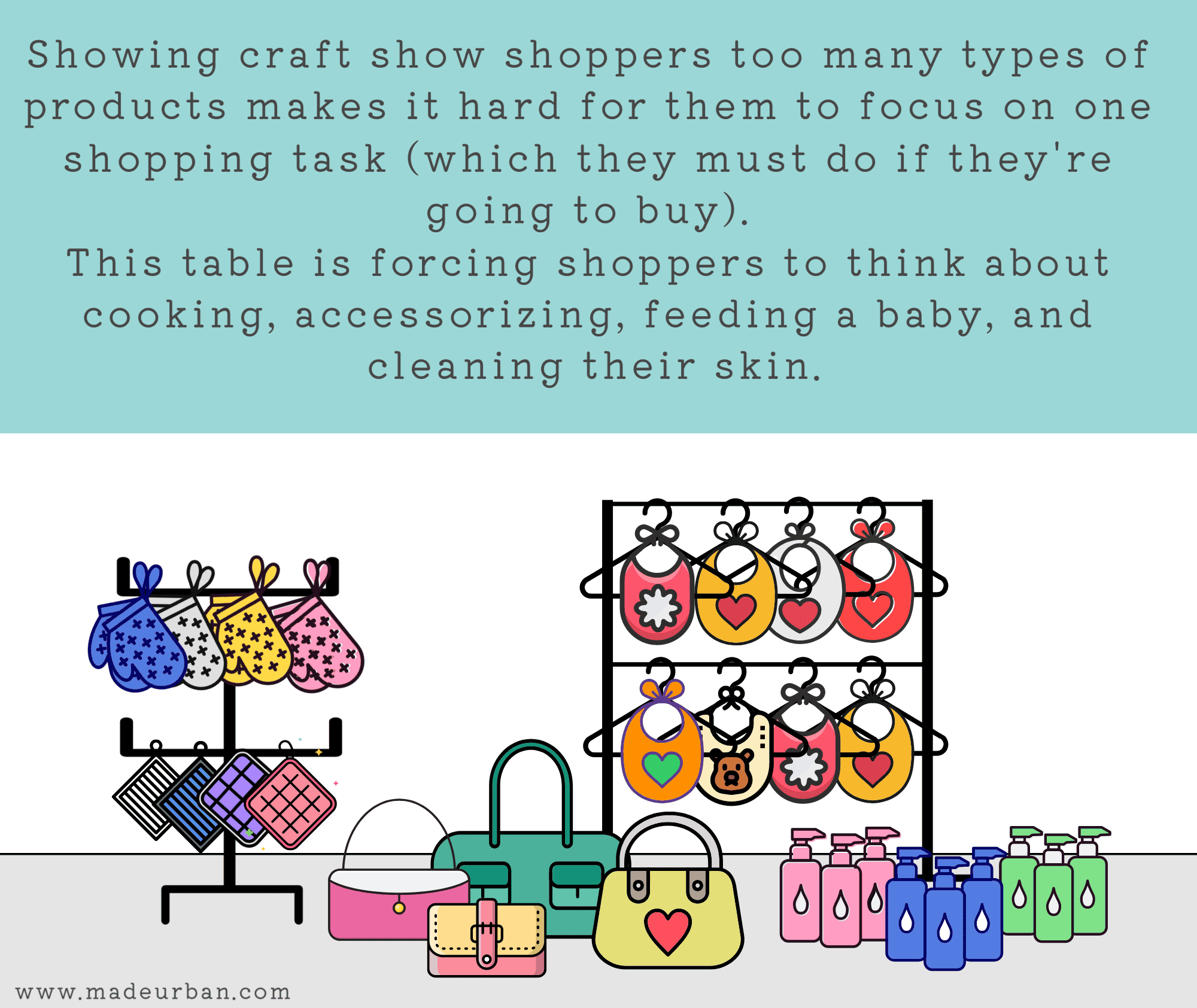
Even when sticking within one category of shopping (e.g. bags), you want shoppers to stay focused on a specific vision.
Too much product variation within a product category can overwhelm your shoppers.
For example, a bag vendor selling evening bags, beach bags, school bags, and duffel bags is forcing a shopper to think about:
>> dressing up for a black-tie event
>> what they might wear when they go to the beach
>> what they need to carry around for school or work
>> what they might use a duffel bag for
Again, it makes it hard for a shopper to keep focus.
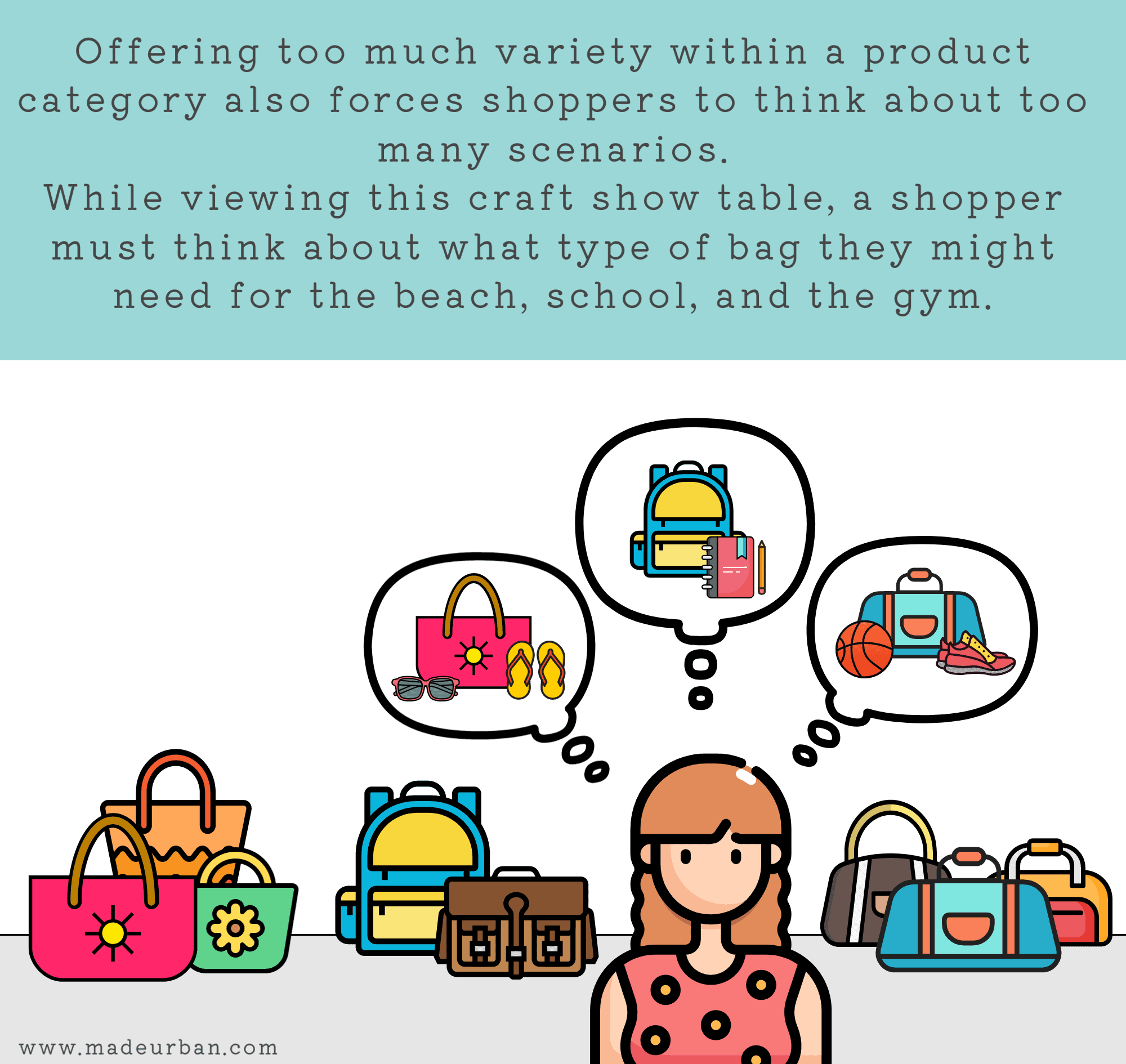
2 – The harms of decision fatigue
When a shopper is forced to make too many decisions (e.g. big or small, red or blue, polka dots or stripes?) it causes decision fatigue.
There are too many decisions to make so they don’t feel like making any.
You NEED your shoppers to feel confident in their decision to buy.
How you’re creating decision fatigue.
You can create decision fatigue by offering too many types of products (e.g. bags, oven mitts, baby bibs, etc.) or by offering too many options for each product.
Product options might be the same product, or type of product, sold in a variety of colors, scents, sizes, etc.
For example, I may only sell one style of bag, a simple tote bag, but offer it in 20 different fabric options, which can create decision fatigue.
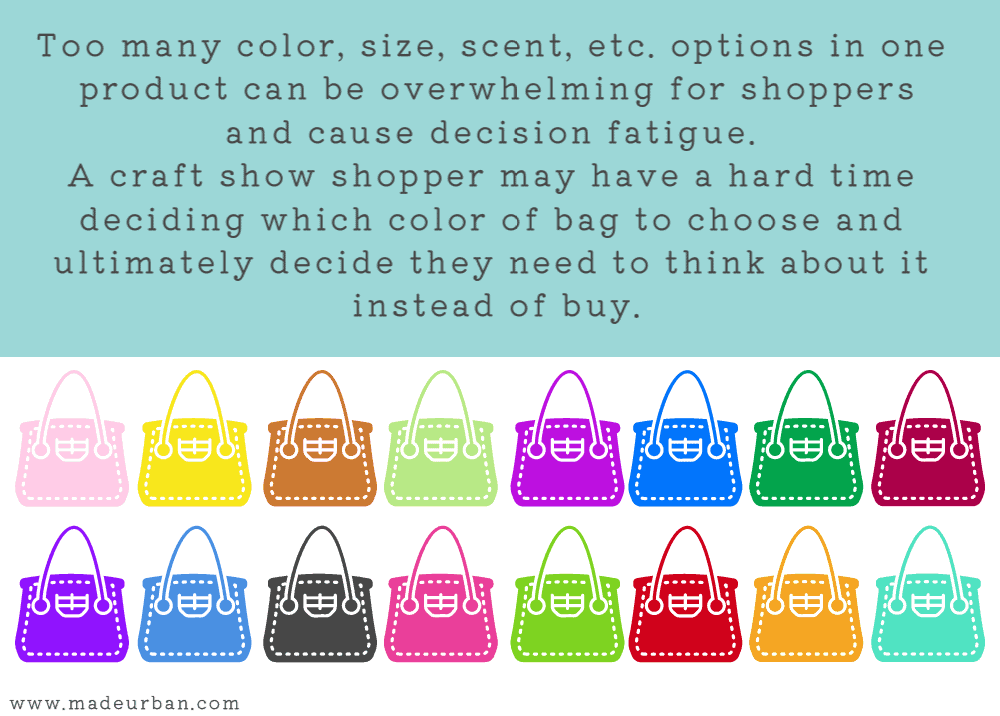
Or, I may be selling one type of product, beach bags, and creating those beach bags in an abundance of styles, colors, prints, materials, sizes, etc. which can create decision fatigue.
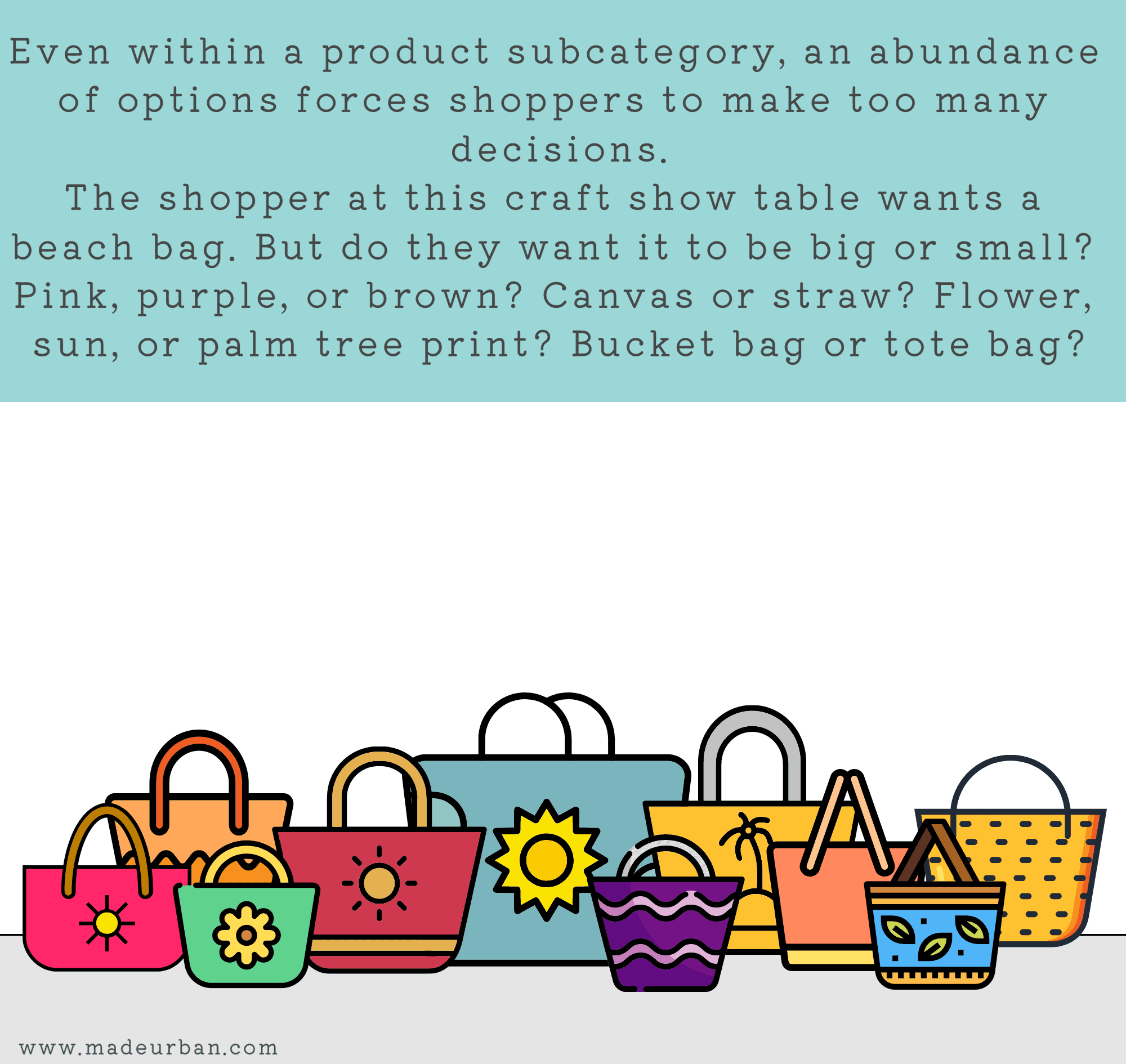
>> Too many style options makes it hard for a shopper to decide which style suits them.
>> Too many colors options makes it hard to pick which color they like best.
>> Too many material options makes a shopper wonder which is best for the beach.
Etc.
Shoppers may love everything in front of them, but have a hard time deciding…am I more straw bucket bag person? Or more of a colourful palm tree person?
You want to give your shoppers options, but you don’t want to overwhelm shoppers with them.
How to edit when you’ve gotten too creative
If your creativity has gotten the best of you and you need to pare down your selection to help shoppers focus and make a decision, follow these steps:
Step 1 – Start with stats
Always, always, always let your sales stats guide your decisions (if you’re trying to build a profitable business).
You may enjoy making one product over another, but focusing your product line around it won’t be a good business decision if consumers don’t want to buy that product.
Find a theme among the products you sell the most of.
For example, suppose I currently sell bags, oven mitts, potholders, tea towels, baby blankets, stuffed animals, soaps, bubble bath, and lotions. I may only sell one or two of each type of product at a craft show, so not one item stands out as a bestseller. But collectively, I may sell more bags than kitchen linens, baby products, or bath products.
Those higher sales would tell me which category of product to focus on.
If you currently sell a lot of different products, it may be hard to spot a pattern or bestseller. In which case, edit your product selection slowly and let each craft show or Etsy sale guide you in the right direction.
Step 2 – Choose 1 shopping focus
As consumers, when we go on a shopping trip, it typically has a focus.
We’re going on a shopping trip to look for a new outfit, decor for our home, or to buy groceries for the week.
Trying to tackle too many shopping goals in one trip feels overwhelming…especially when trying to do so within one store and at the same time.
Your craft show table is a tiny store.
Although a craft show shopper may purchase a new scarf, soap, and pair of earrings at a craft show, they’re highly unlikely to purchase all of them at the same time, from the same vendor.
Having all three types of products in your tiny craft show “store” forces a shopper to think about all of them at the same time.
Your craft show table or Etsy shop should stick to one type of common shopping excursion. For example, one might go on a shopping trip for:
- A new bag
- Hair accessories
- Jewelry
- Skincare
- Bath products
- Wall art
- Etc.
The broader you are with the shopping focus you target, the more you’ll force multitasking and cause decision fatigue.
Step 3 – Pick your purpose
Again, a shopping excursion is often more specific than “I’m shopping for a new bag”. Shoppers are looking for that item because they need it to serve a specific purpose, such as “I need a new bag for work”.
What’s the purpose your products will focus on serving?
For example:
>> If someone is shopping with you for wall art, which room in their house are they decorating? The living room? A bathroom? A nursery?
>> If they’re shopping for soap, what kind of purpose do they want that soap to serve? To gently remove makeup? To smell amazing and clean hands in bathrooms? To help create a toxin-free bathing routine? Although one soap vendor could sell face soap, hand soap, and toxin-free soap, I’m not sure I would trust Bath & Body Works when it comes to gently cleaning my face, or if they all of a sudden came out with a toxin-free, naturally-scented line.
It may be more applicable to your business to consider the specific occasion one might be shopping for when they shop with you.
For example:
>> If they’re shopping for jewelry, are they looking for pieces to wear to a wedding? To a music festival? For running everyday errands?
>> If they’re shopping for a new bag, is that bag to wear to the office? To the beach? To school?
The more occasions or purposes you try to accommodate, the more likely you are to force multitasking and create decision fatigue.
Step 4 – Hone in on your style
The reason shoppers will be drawn to your products/craft show table/Etsy shop is because of the unique style you have to offer.
The more styles you try to appeal to, the more watered down YOUR style becomes.
You should be building a product line that reflects your unique sense of style and attracts your target market.
Don’t try to offer every color under the rainbow; stick to the ones you’re drawn to. Focus on neons, or earth tones, or pastels, but not all three.
The same applies to the styles, patterns, prints, materials, scents, sizes, shapes, etc.
Give yourself, or your target market, a label to describe your/their style and match as many product features to that label as you can, and across as many products as possible.
For example:
>> “Girly-girl” might focus on floral prints/scents, pastel colors, delicate fabrics/materials/details, etc.
>> “Hippy/boho” might focus on earth tones, natural and organic ingredients/materials, toned-down subtle styles (rather than trends), etc.
>> “Playful” might focus on bright primary colors, graphic patterns, etc.
Don’t go too broad when building out your product options.
Stick within your label and make sure everything on your craft show table looks good next to each other (and doesn’t clash).
3 – 5 is a guideline I like to follow:
- 3 – 5 types of products
- 3 – 5 options in a product
- 3 – 5 product collections
That tends to offer plenty of options for shoppers, without losing focus.
For more details, examples, and step-by-step instructions to apply the 3 – 5 strategy, check out: How to Develop a Product Line Using the 3 – 5 Strategy
Let me know in the comments if you have any questions 🙂
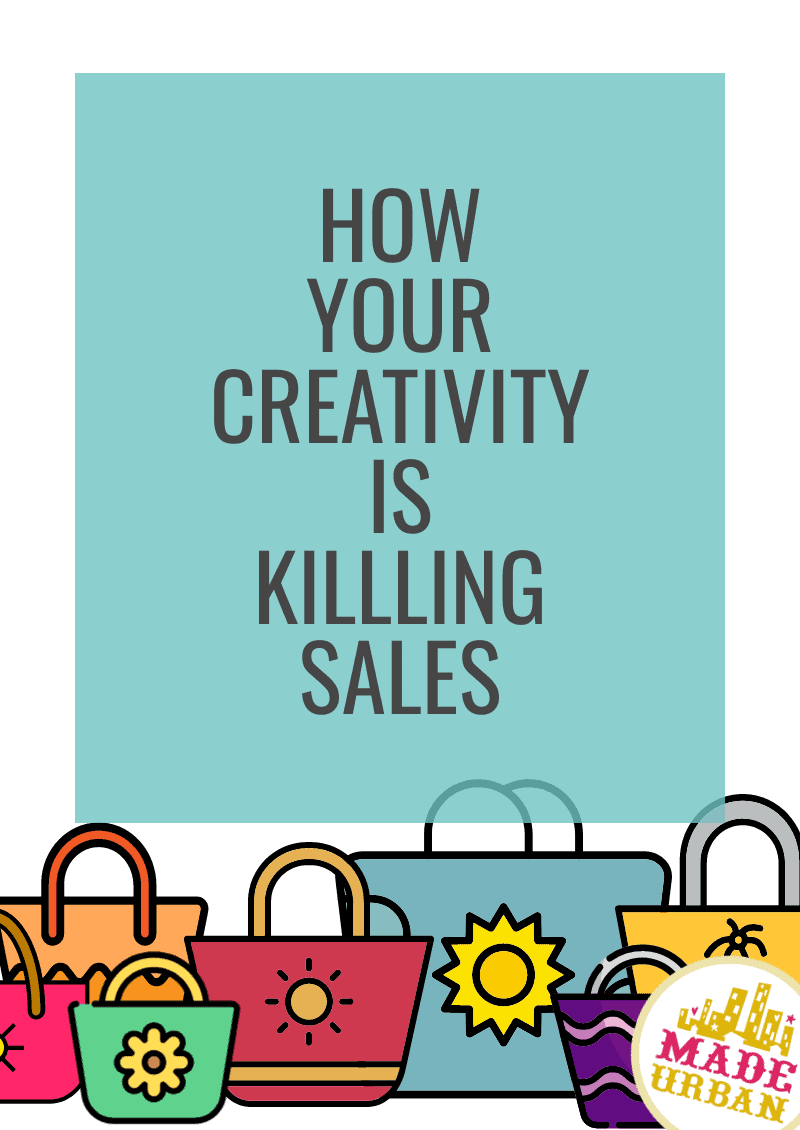

Hey, I’m Erin 🙂 I write about small business and craft show techniques I’ve learned from being a small business owner for almost 2 decades, selling at dozens of craft shows, and earning a diploma in Visual Communication Design. I hope you find my advice helpful!

Hello, we struggle with the too many different things. We do woodworking and we have sales in every category at every show.
He does wood turning, I take his leftovers and create jewelry and decorative pieces. Can’t seem to narrow down the product line due to what kinds of wood we harvest from local cuttings determines what products it’s suitable for. Some shows he sells a lot some shows I sell a lot some shows it’s a hodgepodge of both our items. We are just thankful to sell anything but we are overwhelmed with our inventory and variety!
I have studied your materials for years and they are excellent.
Any help would be appreciated
Thank you
Hi Lorrie,
Thanks for reading! That’s a tough one when you don’t have a clear sales direction and the woods dictate what type of products you can make. In a situation where you aren’t able to narrow down your products into one category (e.g. home decor OR jewelry), then I would create two distinct sections in your craft show display; one for home decor and one for jewelry.
I’m not sure what type of items your husband makes with his wood turning…and I don’t know much about the craft 😉 but I’m guessing they’re home decor pieces. And would your decorative pieces be considered home decor? If so, could you try to focus more of your line on home decor and have a little section (in your zone 3/checkout area) for your jewelry?
There are always exceptions to the “rules” and if this advice doesn’t work for your business, that’s okay. But if you’re feeling overwhelmed with your selection, try going in one direction for a couple of craft shows and see what the results are. Focus on home decor items, or kitchen items and see what the shopper response is. You can bring the jewelry to the event and keep it behind the table, so if you mention it to someone and they’re interested, you can bring it out.
I hope that helps a little!
~Erin
Thank you Erin , you are spot on with your analysis and advice. I appreciate your insightI w wonder if there is a way to use props that people will not continually ask to buy? no matter what I use, people want to buy my props?
Glad it was helpful 🙂 In terms of the props, aside from signs (which may distract from your display) I’m not sure if there’s a great way to stop people asking if they’re for sale. I guess ensuring there aren’t too many props and your products dominate the display so it’s clear you’re selling woodwork peices and not props.
If you can find your props at wholesale prices, you may consider buying extra, having a marked up price in mind, and selling them to customers if they ask. Might be another revenue stream 🙂
~Erin
“How Creativity Is Killing Sales” is exactly what my daughter has been trying to tell me, but you put it in terms that made a lot of sense. I do wood burning (pyrography) and rent space at a local craft/vendor store and do a couple of craft fairs each year. I wood burn on plaques, bookmarks, coasters, key chains, & light switches. I’m trying to establish a “steampunk” style, but everything is not “steampunk” just yet. So because sales were slow at the craft/vendor store, I made decals of my wood burnings and put on tote bags, cosmetic bags, and pencil bags. I haven’t sold any of these. My space is very small. There’s a peg board on the wall for the bookmarks, a 3 tiered shelf under the pegboard, and a rotating greeting card rack (my daughter makes greeting cards) and a tall shelf that gets smaller the higher up it goes. This shelf can only hold about 4-5 wood burnings. After reading your article, I’m going to remove the bags, remove the greeting cards and get a bigger shelf to fill up the space and focus on the plaques. I will leave the bookmarks as that is attached to the wall and will help with having a lower priced item. I thought I wasn’t making sales because I was too high, but now I see your point on having too much variety. Thank you for this insight.
Thanks for reading Judy! I’m glad the explanation resonated! It takes some playing around to find the right niche and product combination, and cutting back can be a scary step, but each event will make it clearer which direction you should go in.
Keep me posted on how your next event goes!
~Erin
Erin, is it possible to create a new kind of product line for bohemian jewelry?
I make jewellery with wire, crystals, gemstones, pearls, small pendants in silver/gold plated.
I would like to add silver rings, pendants with gemstones/glass in a more chunky design. Is that possible? Maby as a collection?
thanks for your very good articles.
Best Annette
Hi Annette!
I agree. I think introducing a chunky design as a collection is a good way to introduce it and test it out.
~Erin
Me reading this while making yet another new, unrelated product. Will pause and reconsider, realizing I’m stressing to get “new” things done before this weekend’s show.
I can’t tell you how many craft shows I stayed up way too late making my latest product idea 😉 Good luck this weekend! Let me know how it goes.
~Erin
I’m not understanding your 3-5 rule. Is it:
3 – 5 types of products OR
3 – 5 product collections OR
3 – 5 options in a product
Hi Sharon,
I’m actually writing an article right now to explain the 3 – 5 strategy as I’ve gotten a few questions about it. But the short answer is it’s 3 – 5 for all.
Start with 3 – 5 types of products, e.g.:
1 – necklace
2 – earrings
3 – bracelet
Add 3 – 5 options for each product, e.g.:
Necklace:
1 – pendant necklace
2 – choker necklace
3 – charm necklace
Earrings:
1 – stud earrings
2 – hooop earrings
3 – drop earrings
Bracelet:
1 – charm bracelet
2 – bar bracelet
2 – cuff bracelet
Create 3 – 5 collections, e.g.:
1 – Gold collection (containing necklace, earrings, and bracelet options)
2 – Silver collection (containing necklace, earrings, and bracelet options)
3 – Rose gold collection (containing necklace, earrings, and bracelet options)
I’ll have the article up shortly to better explain and will link to it from here.
~Erin
Thank you Erin for explaining Sharon’s question deeper. I have a further question around this, but I will wait for your article to see if it answers it. I look forward to reading it soon. Many thanks for your great articles. They are so very practical & helpful.
Hi Gina,
Glad that explanation helped a little. Here’s the article expanding on the strategy: https://www.madeurban.com/blog/how-to-develop-a-product-line-using-the-3-5-strategy/
Please let me know if anything is unclear or if you still have questions.
Thanks for reading! 🙂
~Erin
I have read your articles for several years and several of them have focused on a similar theme – simplify. I remember your example about jams/jelly.
While I understand what you are saying and why, I still struggle with testing it out. Here’s why. I’m a sewer. Aprons, hot pads, gift bags. Let’s focus on aprons. I have infants (ages 1-2), boys/girls (ages 3-7) and adults.
The last show I went to, I took 30 completely different infant aprons, 75 kid aprons (boys and girls combined) and 60 adult aprons.
I separate them on racks by type – so for kids I have separators for boys, dogs/cats, holidays, and girls. For adults, I have separators for coffee/cats, southwest, holiday and all other.
Having gone through your worksheets on defining your UNIQUE SELLING PROPOSITION, mine is the widest selection of kid and adult aprons. I can’t tell you how many shoppers comment on what wonderful fabric options I offer.
Here’s one example. A woman was looking at all 75 kid aprons and found one with whales. Turns out her son lives on the east coast and loves whale watching. Her son just had a baby and she bought an infant apron with whales on it. She was just tickled to death to find that fabric. In all honesty, I haven’t sold another one, but I still remember how happy she was. Even if I don’t ever sell another one ever, that sale made my day.
Another lady was going through all 75 kid aprons and found one with illustrations of little girls on ponies. Turns out, her granddaughter lives on a farm and loves horses. Same thing, she was so happy.
I have people come back to my booth and share with my photos of their grandkids in the kitchen with the special apron they purchased from me.
It just warms my heart when I’m able to offer such a specific solution to these customers. If I left the whale or pony aprons at home perhaps the customer would have settled for one of my other aprons. But finding just the perfect one was pure joy for both the customer and for me.
It does take a lot of space and a long time to set up given all the options I offer. Do you think I need an intervention? I don’t just want to keep selling the most popular ones; to your point, I feel that would dampen my creativity (and my desire to purchase more fabric!!!)
How do you suggest I balance my USP of having the largest selection of fabric options with your very rationale and logical argument that you shouldn’t offer customers too many choices?
Hi Laurie,
Thanks for commenting! Wow, that’s impressive…75 aprons for kids alone. You must be a speedy sewer 😉 I understand the appeal of making those special connections with your customers. What may be a more effective and profitable way to create those moments is to take custom orders so you can match a specific interest with a fabric, without having to make so many options.
To answer your question, I’m not sure you can balance “largest selection of fabrics” with limiting choices. If you’re wanting to cut down on how many options you offer, I would suggest altering your USP.
Having the “largest selection” doesn’t speak to a specific customer. It attracts a wide range of customers (from whale watchers to horse lovers) but that means you need to have something for everyone, which is very hard for a small business to keep up with and be profitable. So to cut down on your selection and strengthen your USP, try working a target market into your unique selling position (e.g. aprons for kids who love animals).
You can still be creative, but just turn your creativity towards developing collections and combining fabrics.
I hope that helps!
~Erin
Erin:
Thank you for your very thoughtful response.
I have done a few custom orders over the years. They are more difficult; if a customer wants a material I don’t already have, then I have to source it and typically pay higher retail price (which significantly reduces my profit) and spend time back and forth explaining and sharing options. I’ll take a custom order, but it’s not my preferred method of selling.
A few times, I have left some aprons at home due to space considerations. One time I left my only two men aprons at home; a lady asked about men aprons. Go figure!!! I told her I had a really great apron with beer fabric. I live 10 minutes away from her. Offered to come to her house or she could come to my house; no she said. Gave her my business card; never heard back. Same with a lady whose daughter is a pastry chef. She wanted a custom apron; we talked for quite a while. Gave her my card; never heard back.
My impression is people want to buy on the spot.
My big test regarding downsizing/consolidating will be in July. I’m doing an indoor event with an 8 foot table. I usually have a 10 x 10 booth; so 8 feet for aprons, hot pads and gift bags is really, really tight. Obviously, I can’t bring all my aprons so I am already thinking about how I talk about all the other options I have. Or, I might tuck some under the tables.
Is there any research to suggest that having MORE options make people purchase more versus paralyzing them? Or, does everyone shop the same – too many options is a detriment to higher sales? I was at Kohl’s today; they have 30 different white women’s tennis shoes. Starbucks has dozens and dozens and dozens of coffee options.
I do not have a retail background which is why I read as much as I can to hone my skills and why I so appreciate you sharing your wealth of knowledge about retail sales, visual merchandising and displays. Laurie
Hello Erin, we have spoken before and I sent pictures to you of my Booth. I have taken your advice, however, this article is spot on. I just finished up with the Maricopa County Fair. I set up my Booth with a Farmer’s Market Items. With all my Items my Booth looked like I had 5000 Items to Sell. I thought about all your other articles and I didn’t do what you suggested. My Sells were junk! I should have stayed with my 3 unique niches, which are Crepe Paper flowers Cardstock Paper flowers and Cacti Desert Blooms. Now, I have about 100 Items I need to have blow out sale. I’m doing that blow out sell today Saturday and Sunday at my local Swap Meet. I’ll sell everything at my cost just to get back in track with my unique niches. I learned a big lesson, way to many different Items killed my sells. Thanks again for your help with your awesome articles. BTW, I have already cleaned up my website. My unique niches are on my website. PS, this is my new email address and New website. Tim
Hi Tim!
Great to hear from you! Sorry to hear you didn’t have a great event. But I’m happy to hear that your 3 niches work for you and your sales reflect that. Sometimes you have to test things out to be sure 🙂
~Erin